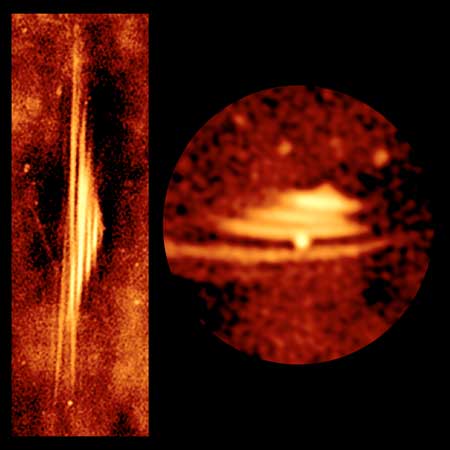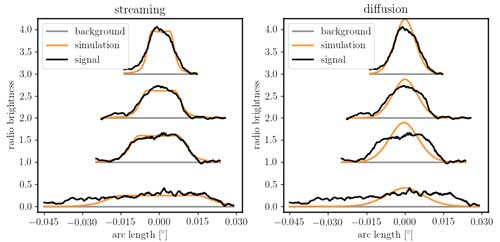| Dec 19, 2019 |
Of harps, Christmas trees, a wandering star and the mysterious streams of cosmic rays
|
|
(Nanowerk News) Researchers at the Leibniz Institute for Astrophysics in Potsdam (AIP), and the Max Planck Institute for Astrophysics in Garching (MPA), have investigated galactic radio objects that adopt shapes such as Christmas trees and harps. They were able to answer the old question of the transport of cosmic rays.
|
 |
| Radio synchrotron harp and Christmas tree in the galactic center. Right: The star which emitted the particles moved through the centre of this structure, from bottom to top, and is now at its tip. The particles flow left and right along the horizontal magnetic field lines. Left: The synchrotron radiation of the particles traces the magnetic field lines, making them visible in the form of harp strings. (Image: T. Thomas (AIP) / MeerKat)
|
|
The inner region of our Milky Way galaxy is characterised by large amounts of warm gas, cosmic-rays and enhanced radio emission.
|
|
“Astronomers have been observing planar radio-emitting magnetised structures in the galactic centre for almost twenty years. Recent observations with the MeerKAT telescope in South Africa show that these are organised into groups of almost parallel filaments, that span over a length of several light years,” reports Timon Thomas from the AIP, the leading author of the study ("Probing Cosmic Ray Transport with Radio Synchrotron Harps in the Galactic Center"). “The filaments are seemingly sorted by their length, so that they look like the strings of a harp.”
|
|
Hence, researchers from Potsdam and Garching called these objects radio synchrotron harps. Synchrotron is the name of the mechanism that generates the radio emission. It arises when charged particles like electrons are accelerated in magnetic fields.
|
|
“The observed structures are created when massive stars or pulsars fly through an ordered magnetic field and discharge cosmic ray particles along their path into these magnetic fields,” explains co-author Christoph Pfrommer from AIP. “The particles propagate along the magnetic field lines, usually transverse to the stellar orbit, causing the magnetic fields in the radio regime to light up and appear like the strings of a harp.”
|
 |
| The observed brightness profiles (black) of the radio emission along the investigated harp strings are compared to model calculations (orange) with streaming and diffusion (left) and only with diffusion (right). In the lower two profiles the particles had more time to spread; here the models show clear differences. The one with streaming and diffusion can explain the observed profiles well while the one with diffusion only shows clear deviations. The importance of streaming visibly increases with time and should thus be the more important contribution to the transport of cosmic rays over even greater distances in our Galaxy. (Image: Thomas, Pfrommer, & Enßlin) (click on image to enlarge)
|
|
So far, the exact transport process of the particles along these strings has been a mystery. The researchers now assume that the individual strings show a chronological sequence in which the particles have spread along the magnetic field lines from their point of release.
|
|
If this propagation was a diffusion process, the structures seen in the radio observations should have rounded bell shapes, but they do not. By measuring one of the harps and performing detailed model calculations, the astrophysicists were able to show that streaming must be the most important transport process of cosmic rays.
|
|
“The particles "pluck" the strings and stimulate the magnetic fields to oscillate, which in turn hold the particles together to form a streaming fluid,” explains Torsten Enßlin from MPA, who initiated the study.
|
|
With this illuminating Advent insight, the decades-old mystery of the transport of cosmic ray particles has been solved. Contrary to the previous assumption of diffusing particles, it turns out that they mainly stream.
|


